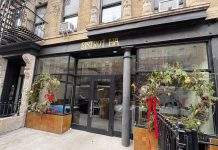
Last week, we filed a brief report after Community Board 3’s landmarks subcommittee voted in favor of protecting the Bialystoker Nursing Home building, at 228 East Broadway. Today — a more detailed account from the public hearing, which offered the most expansive explanation yet from nursing home board members about their decision to close the Lower East Side institution after 80 years and to sell the building as a development site.
Shortly after the home closed last year, preservationists filed an application with the city to designate the 1929 building an historic landmark. The nursing home board opposed this move, arguing that landmarking would scare off prospective buyers. The Landmarks Preservation Commission has not announced whether it intends to ‘calendar” the application and schedule a public hearing on the matter. Community activists hoped an endorsement from the CB3 would compel the commission to act.
Last Tuesday evening, the nursing home’s public relations firm (Geto & deMilly) handed out a statement from the board of trustees spelling out its position. The statement made the argument that landmarking would deprive the nursing home’s union and other creditors of millions of dollars they are owed:
As part of its state-approved closure plan, the Bialystoker Board is now attempting to raise the $13+ million in capital that will allow it to honor its obligations to the nursing home’s 115 loyal employees with respect to past due wages, benefits and pension funding. It is also the Board’s goal to reimburse our vendors, many of which are local businesses, as well as remit remaining taxes and funds owed to Medicaid. These obligations have real-life implications for the working families depending on this compensation, and for local businesses that cannot afford such a loss. However, the $13+ million needed to make good on these obligations can only come from the sale of the site… The Bialystoker Board is now in the process of entering into a contract of sale to the highest bidder. The sale has been approved by the Attorney General… If this building were to be designated a landmark, options for its adaptive reuse would be severely limited (due to its narrow configuration and advanced disrepair)… Thus it could only be sold at a significant discount, which would likely thrust Bialystoker into bankruptcy and ensure that our deserving employees will not receive the full amount of compensation owed to them.
Preservationists in attendance countered the nursing home’s arguments from a variety of perspectives. First off, they said it’s shortsighted to tear down a building that not only has architectural significance but is also symbolic of the Jewish experience on the Lower East Side. Elissa Sampson, a longtime LES resident, argued that the Bialystoker building is “representative of immigrant labor in every sense.” Immigrant workers (almost all of whom worked in the garment industry) paid $10 per brick to build the home.
Mitchell Grubler, a leader of Friends of the Bialystoker Home, detailed several government programs that could be used to help pay for the building’s renovation and made the case that preservation does not necessarily mean financial ruin. Eric Mandelbaum, the president of the neighboring Seward park Cooperative, also spoke in favor of saving the building (he was speaking only for himself, not the co-op board).
Leah Gonzalez, representing the union, 1199 SEIU Healthcare Workers East, acknowledged that the Bialystoker “is clearly a beloved building.” But she went on to urge community board members to “give serious consideration to the impact (on preservation) on our workers, all of whom are unemployed (several months after the nursing home’s closure).” Gonzalez said the union is owed about $4 million in back wages and benefits. In opposing preservation, she said, “we are not left with a lot of options.”
At least two Bialystoker board members were present at the meeting, including Gary Ambrose, who offered an account of the home’s financial woes. The closure, he said, “broke my heart.” Ten years ago, he indicated, the board was advised to close the home, but they were determined to keep it going. In the end, he told CB3 members, the Bialystoker was losing $1 million a month. The building had become dangerous to both residents and employees. Ambrose said an intensive search was begun for a “white knight,” but no one would touch it” if the building was landmarked. He estimated that the winning bid was around $17 million. Alys Kremer, another longtime board member, implored the community board not to “put buildings before people.” She added, “I urge you to be unsentimental about this.”
Preservationists have often pointed to the Bialystoker’s facade, which includes etchings depicting the Twelve Tribes of Israel. The Nursing home board has suggested these and other design elements could be removed and preserved before the building is demolished. But David Adams, a Community Board member and observant Jew, argued that people are making too much of the Bialystoker’s historic significance.
“It’s not that significant or unique,” he said. Adams elaborated, suggesting that it’s better to “live in the present day,” adding that “making monuments to the past is not what we’re about. We’re about the future.” Adams also suggested the nursing home board members, who he said “come from my community,” explored every possibility.
In the end, Adams was the only community board member to vote against the resolution, which called on the Landmarks Commission to “promptly calendar and landmark the Bialystoker Nursing Home building.” Next month, CB3’s Parks Committee will vote on the resolution before its forwarded to the full board at the end of April.
As we reported last week, the State Attorney General’s office would not confirm it has approved the sale of the Bialystoker. Nursing home representatives did not indicate whether the real estate contract gives the prospective buyer an “out” if the building is landmarked in the weeks or months ahead. Other parties – who are thinking in terms of renovating the Bialystoker rather than demolishing it – are waiting in the wings. They have, however, made it clear they could not pay “top dollar” for a building that has landmark status and would require millions to rehab. One non-profit organization, Two Bridges Neighborhood Council, tried to contact representatives of the Bialystoker about possibly creating affordable housing in the building. Their overtures were rebuffed.
City Council member Margaret Chin has been in contact with both preservationists and the Bialystoker board, in an effort to find a solution to the dilemma. State Assembly Speaker Sheldon Silver has declined to weigh on on the issue, but has told community activists that he might take a position if the community board passes its resolution next month.











